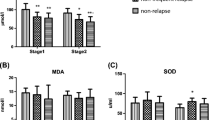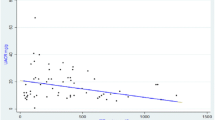Abstract
Background
Recent observation revealed that serum albumin plays an important role in the host defense mechanism as it is one of the important antioxidants. This study was conducted to investigate whether hypoalbuminemia contributes to a decreased biological antioxidant potentials (BAP) in idiopathic nephrotic syndrome (INS).
Methods
Fifty three heparinised blood samples were obtained from 8 patients with INS (median 13.5 years). Eighteen samples from 6 patients with Henoch–Schönlein purpura (HSP median 7 years) were served as control. Intravenous human albumin preparation was also applied for comparison. Measurement of BAP in blood and human albumin preparation was determined by a newly developed devise called FRAS4®. Comparison among groups and relationships between BAP and albumin concentrations or c-reactive protein (CRP) were studied by Kruskal–Wallis test and Spearman rank correlation test, respectively.
Results
Serum levels of BAP was significantly lower in patients with nephrotic relapse than those in patients with nephrotic remission or HSP. BAP correlated well with serum albumin levels. Positive relationship was also found between concentration of albumin in human preparation and BAP. Weakly positive CRP sera disclosed both hypoalbuminemia and low BAP.
Conclusion
Our results suggest that decreased antioxidant potentials caused by hypoalbuminemia in INS may contribute to an aberrant immunity.



Similar content being viewed by others
References
Eddy AA, Symons JM. Nephrotic syndrome in childhood. Lancet. 2003;362:629–39.
Hingorani SR, Weiss NS, Watkins SL. Predictors of peritonitis in children with nephrotic syndrome. Pediatr Nephrol. 2002;17:678–82.
Uncu N, Bülbül M, Yildiz N, Noyan A, Koşan C, Kavukçu S, et al. Primary peritonitis in children with nephrotic syndrome: results of a 5-year multicenter study. Eur J Pediatr. 2010;169:73–6.
Haynes GR, Navickis RJ, Wilkes MM. Albumin administration—what is the evidence of clinical benefit? A systematic review of randomized controlled trials. Eur J Anaesthesiol. 2003;20:771–93.
Chen TA, Tsao YC, Chen A, Lo GH, Lin CK, Yu HC, et al. Effect of intravenous albumin on endotoxin removal, cytokines, and nitric oxide production in patients with cirrhosis and spontaneous bacterial peritonitis. Scand J Gastroenterol. 2009;44:619–25.
Roche M, Rondeau P, Singh NR, Tarnus E, Bourdon E. The antioxidant properties of serum albumin. FEBS Lett. 2008;582:1783–7.
Nishikawa T, Okamoto Y, Kodama Y, Tanabe T, Shinkoda Y, Kawano Y. Serum derivative of reactive oxygen metabolites (d-ROMs) in pediatric hemato-oncological patients with neutropenic fever. Pediatr Blood Cancer. 2010;55:91–4.
El-Melegy NT, Mohamed NA, Sayed MM. Oxidative modification of low-density lipoprotein in relation to dyslipidemia and oxidant status in children with steroid sensitive nephrotic syndrome. Pediatr Res. 2008;63:404–9.
Ece A, Atamer Y, Gürkan F, Davutolu M, Koçyiit Y, Tutanç M. Paraoxonase, total antioxidant response, and peroxide levels in children with steroid-sensitive nephrotic syndrome. Pediatr Nephrol. 2005;20:1279–84.
Karthikeyan K, Sinha I, Prabhu K, Bhaskaranand N, Rao A. Plasma protein thiols and total antioxidant power in pediatric nephrotic syndrome. Nephron Clin Pract. 2008;110:c10–4.
Dogra G, Ward N, Croft KD, Mori TA, Barrett PH, Herrmann SE, Irish AB, Watts GF. Oxidant stress in nephrotic syndrome: comparison of F(2)-isoprostanes and plasma antioxidant potential. Nephrol Dial Transpl. 2001;16:1626–30.
Kamireddy R, Kavuri S, Devi S, Vemula H, Chandana D, Harinarayanan S, et al. Oxidative stress in pediatric nephrotic syndrome. Clin Chim Acta. 2002;325:147–50.
Natarajan SK, Mukhopadhya A, Ramachandran A, Amalanathan S, Kurian G, Balasubramanian KA. Spontaneous bacterial peritonitis results in oxidative and nitrosative stress in ascitic fluid. J Gastroenterol Hepatol. 2007;22:177–81.
Ramachandran A, Balasubramanian KA. Intestinal dysfunction in liver cirrhosis: its role in spontaneous bacterial peritonitis. J Gastroenterol Hepatol. 2001;16:607–12.
Mariano F, Tetta C, Montrucchio G, Cavalli PL, Camussi G. Role of alpha 1-proteinase inhibitor in restraining peritoneal inflammation in CAPD patients. Kidney Int. 1992;42:735–42.
Acknowledgment
This study was partly supported by the Mami Mizutani Foundation.
Conflict of interest
None to declare.
Author information
Authors and Affiliations
Corresponding author
About this article
Cite this article
Kaneko, K., Kimata, T., Tsuji, S. et al. Serum albumin level accurately reflects antioxidant potentials in idiopathic nephrotic syndrome. Clin Exp Nephrol 16, 411–414 (2012). https://doi.org/10.1007/s10157-011-0578-y
Received:
Accepted:
Published:
Issue Date:
DOI: https://doi.org/10.1007/s10157-011-0578-y




